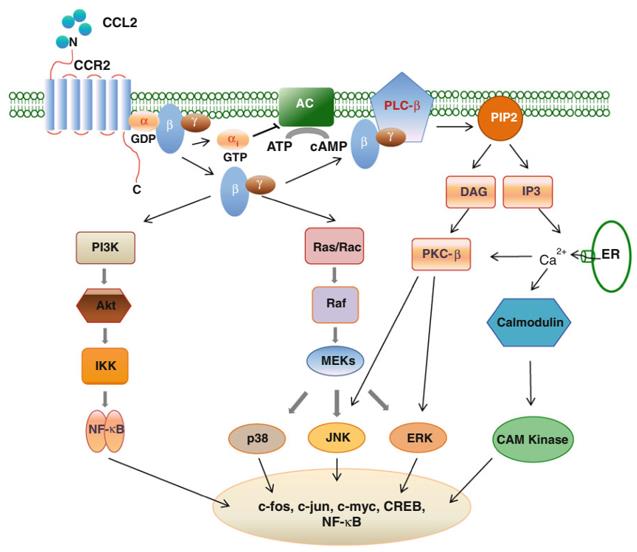
Our promise to you:
Guaranteed product quality, expert customer support.
 24x7 CUSTOMER SERVICE
24x7 CUSTOMER SERVICE
 CONTACT US TO ORDER
CONTACT US TO ORDER
CCR2 Gene Editing 
The chemokines mediate their biological effects by interacting with glyco-protein receptors coupled to a G protein signaling pathway. It has been found that most chemokine receptors can be activated by several chemokines. Many studies have shown that the chemokine receptor CCR2 can bind to five proinflammatory CCLs: CCL2, CCL7, CCL8, CCL12 and CCL13. Among them, CCL2 is the most potent inducer of the signal transduction pathways resulting in monocyte transmigration. CCR2 is the representative of G protein-coupled receptor (GPCR) protein. In humans, there are two alternatively spliced forms of CCR2, namely CCR2A and CCR2B that are 360 amino acids and 374 amino acids in length, respectively. These two forms of CCR2 differ only in the C-terminal tail of the protein, which is crucial for receptor trafficking to the cell membrane.
CCR2: Signal Transduction and Regulation
CCL2 (MCP-1) is a member of the CC chemokine family. CCL2 is initially described as a "tumor-derived chemotactic factor", and has been proven to be a potent chemoattractant for several types of immune cells, including the monocytes, memory T cells, natural killer cells, and immature dendritic cells, thus mediating multiple proinflammatory effects and neoangiogenesis. The main ligand of CCR2 is CCL2. The signaling mechanism of the CCR2 receptor is related to G protein of the Gai class. Binding of the N-terminal segment of CCL2 to CCR2 triggers dissociation of GDP from Gai and replacement of GDP by intracellular GTP. This is followed by dissociation of the Gai-GTP complex from the receptor and formation of the Gbc heterodimer. Therefore, Gai inhibits adenylate cyclase, whereas Gbc activates phospholipase C to produce diacylglycerol and inositol 1,4,5-trisphosphate (IP3). These events ultimately result in the release of calcium from intracellular stores and activation of signaling cascades including calmodulin-dependent protein kinase II (CaMKII), protein kinase C (PKC), Akt, PI3K, and ERK, which are involved in cell migration, survival, transcriptional regulation and the release of pro-nociceptive molecules. In addition, it has been shown that CCL2 dramatically induces phosphorylation of p38 MAPK, which then acts to increase the level of phosphorylation of the transcription factor cAMP response element-binding protein (CREB). A large number of mediators for the CCR2 signaling cascade indicate that a wide range of intracellular pathways may be involved in the cellular responses elicited by CCL2. It is worth noting that the serine and threonine residues abundantly present in the C-terminal tail of CCR2 can be phosphorylated after receptor activation, leading to desensitization of the receptor and subsequent termination of the signal transduction.
 Figure 1. Schematic diagram of the CCL2/CCR2 intracellular signaling pathways. (Bose S, Cho J., 2013)
Figure 1. Schematic diagram of the CCL2/CCR2 intracellular signaling pathways. (Bose S, Cho J., 2013)
CCL2/CCR2 Signaling in Cancer Pathogenesis
Many types of cells present in the primary and metastatic tumor microenvironments, including stromal cells, endothelial cells, leukocytes, and tumor cells, produce CCL2. Prostate cancer cells PC-3, LNCaP, C4-2B, and VCaP produce higher amounts of CCL2 than primary prostate epithelial cells. Tumor and stroma cells secrete CCL2 to recruit inflammatory monocytes and TAMs expressing CCR2. Monocytes recruited to tumor sites through the CCL2-CCR2 axis are polarized to TAMs, contributing to tumor cell survival. In addition to direct effects on tumor and endothelial cells, CCL2 also recruits various immune cell subsets including monocytes and macrophages to site of metastasis, and mediates differentiation and polarization of these cell types.
CCL2 has a direct impact on tumor growth in an autocrine and paracrine fashion in multiple cancers, including lung, cervix, ovary, breast, sarcoma, and prostate. In conclusion, the cooperation between tumor-derived chemokines and host/adipose tissue-derived chemokines, especially CCL2, through CCR2 signaling considerably contributes to tumor cell survival, proliferation, and metastasis, which makes CCR2 a potential therapeutic target in cancer treatment.
CCR2 Gene Editing Services
CRISPR/Cas9 PlatformCB at Creative Biogene is dedicated to offering comprehensive CRISPR/Cas9 gene editing services and products for academic research, biotech research and pharmaceutical drug discovery. With deep gene editing knowledge and extensive experience in experimental operation and data processing, we help you effectively control CCR2 genes knockout/knockin/point mutation in cells or animals via CRISPR/Cas9 technology.
| Service | Details | Alternative cell lines or animal species |
| CCR2 Gene Editing Cell Line Generation | gRNA design and synthesis Transfect the cell lines you're interested Select the high expression cells and sort monoclonal cell Validate the knockout/knockin/point mutation of CCR2 by PCR and sequencing Provide cryogenically preserved vials of stable cells and final reports | HEK239T, Hela, HepG2, U87, Ba/F3, CHO, MDA-MB-453, MDA-MB-231NIH3T3, T47D, Neuro2a, MCF7, RKO, K562, RAW264.7, etc. |
| CCR2 Gene Editing Animal Model Generation | CCR2 gene conventional knockout animals CCR2 gene conditional knockout animals CCR2 point mutation animals CCR2 knockin animals | Mouse, rat, rabbit, zebrafish, C. elegans, etc. |
Related Products at CRISPR/Cas9 PlatformCB
| CATALOG NO. | PRODUCT NAME | PRODUCT TYPE | INQUIRY |
| CDKM-0722 | B6J-Ccr2em1Cflox | Knockout Mouse | Inquiry |
References
- Bose S, Cho J. Role of chemokine CCL2 and its receptor CCR2 in neurodegenerative diseases. Archives of pharmacal research, 2013, 36(9): 1039-1050.
- Hao Q, et al. CCL2/CCR2 signaling in cancer pathogenesis. Cell Communication and Signaling, 2020, 18(1): 1-13.
- Lim S Y, et al. Targeting the CCL2-CCR2 signaling axis in cancer metastasis. Oncotarget, 2016, 7(19): 28697.
- Chu H X, et al. Role of CCR2 in inflammatory conditions of the central nervous system. Journal of Cerebral Blood Flow & Metabolism, 2014, 34(9): 1425-1429.